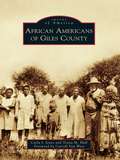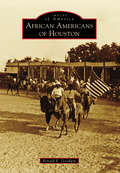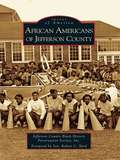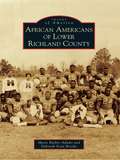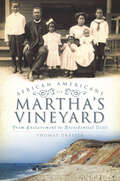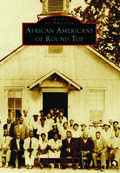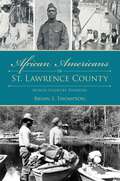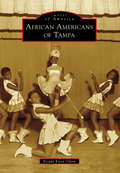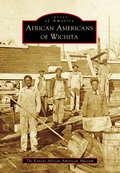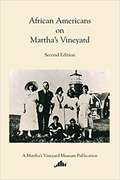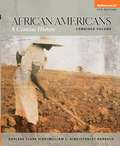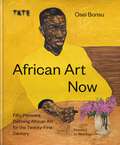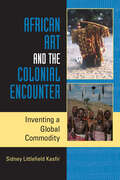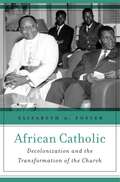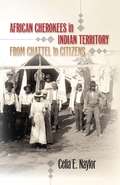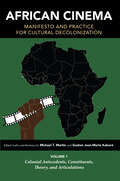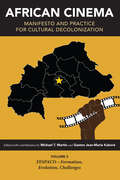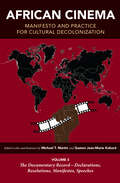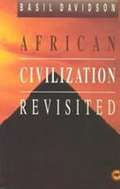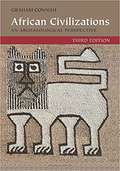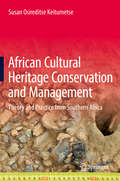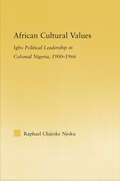- Table View
- List View
African Americans of Giles County (Images of America)
by Carroll Van West Tonya M. Hull Carla J. JonesGiles County was founded on November 14, 1809, and is known as the land of milk and honey. The county is home to over 30 National Register properties, Civil War skirmish sites, a varied cultural heritage, and intersecting Trail of Tears routes (Benge's and Bell's). It is also the beginning place for many well-known African Americans, such as noted architect Moses McKissack, founder of McKissack and McKissack. Giles County is a place where many ancestral lineages return home to their roots for research or to discover their rich African American history and heritage.
African Americans of Houston (Images of America)
by Ronald E. GoodwinTexas is a Southern state, and in many ways, Houston is a typical Southern city. While Houston did not experience the types or degrees of racial violence found in other Southern cities during the Jim Crow era, black Houstonians nonetheless found themselves often relegated to the margins of society. For decades there were two distinct Houstons: one white and the other black. However, Houston's black community created businesses that flourished and schools that educated children and developed a culture that celebrated the accomplishments of their parents while eagerly anticipating the accomplishments of future generations. Images of America: African Americans of Houston captures the many facets of black Houston. From churches to nightclubs; city parks to city hall; and political giants Barbara Jordan, Mickey Leland, and Sheila Jackson Lee to the driving beats of Archie Bell and the Drells, the Ghetto Boys, and Beyoncé, black Houston is alive with a determination that past injustices will never dampen the future opportunities for greatness.
African Americans of Jefferson County (Images of America)
by Inc. Sen. Robert Byrd Jefferson County Black History Preservation SocietyJefferson County can proudly claim a large number of firsts when it comes to African Americans in national history. The raid to free slaves that served as a catalyst for the Civil War was led by abolitionist John Brown in Harpers Ferry. The first man wounded in the rebellion was Heyward Shepherd, a free African American and a Jefferson County resident. Pres. Abraham Lincoln appointed Jefferson County native Martin Robison Delany as the first African American field officer of the Civil War. In 1906, the Niagara Movement, forerunner to the National Association for the Advancement of Colored People (NAACP), held its first meeting on American soil on the Storer College campus. The first woman to become the coach of a men's college basketball team was also an African American from Jefferson County. Additionally, the Colored Horse Show held in Charles Town was the first of its kind for African Americans.
African Americans of Lower Richland County (Images of America)
by Deborah Scott Brooks Marie Barber AdamsLower Richland County encompasses approximately 360 square miles in the heart of South Carolina's geographic center. The Wateree River cradles it to the east, and the Congaree River borders the south and southwest. Virginia settlers discovered this rich land over 250 years ago. They became wealthy planters and accumulated large land tracts, creating plantation systems that sustained the economy. From 1783 until 1820, cotton was the principal cash crop, and the slave population increased tremendously and played a vital role in the development of agriculture and the economy in the area.
African Americans of Martha's Vineyard: From Enslavement to Presidential Visit (American Heritage)
by Thomas DresserAfrican Americans of Martha's Vineyard have an epic history. From the days when slaves toiled away in the fresh New England air, through abolition and Reconstruction and continuing into recent years, African Americans have fought arduously to preserve a vibrant culture here. Discover how the Vineyard became a sanctuary for slaves during the Civil War and how many blacks first came to the island as indentured servants. Read tales of the Shearer Cottage, a popular vacation destination for prominent blacks from Harry T. Burleigh to Scott Joplin, and how Martin Luther King Jr. vacationed here as well. Venture through the Vineyard with local tour guide Thomas Dresser and learn about people such as Harvard professor Henry Louis Gates and President Barack Obama, who return to the Vineyard for respite from a demanding world.
African Americans of Monterey County (Images of America)
by Jan Batiste AdkinsPeople of African heritage have traveled to Monterey since the 1770s, when African Spaniard Alexo Nino, a ship's caulker, traveled with Fr. Junipero Serra to Monterey via the San Antonio. For centuries since Nino, black men and women migrated to the Monterey Bay area in search of a new life. In the 20th century, some African Americans established businesses, bought homes, and encouraged family members and friends to settle in Monterey County. Others pursued military careers. Out of these communities came churches, schools, service organizations, and social groups. For the next century, the history of Monterey County's African American communities have mirrored the nation's slow progress toward integration with triumphs and setbacks that have been captured in images of employment opportunities, churches, business successes, and political struggles.
African Americans of New Orleans (Images of America)
by Phoenix Savage Turry FluckerEnslaved Africans and free people of color of Louisiana deserve the title of "Founding Fathers" just as much as the French, the Spanish, and the Americans. In spite of their subjugated role as slaves, African Americans of Louisiana, and subsequently New Orleans, were contributors to the success of the state and the city far beyond their role within the labor force. Imported into the Louisiana Territory by John Law's Company of the Indies, enslaved Africans, fed on a pound of corn a day, gave birth to American figures of the 19th and 20th centuries. Mahalia Jackson, Louis Armstrong, Homer Plessy, Marie Laveau, Buddy Bolden, Julies Lion, Alice Dunbar-Nelson, the fighting men of the Louisiana Native Guard, Ernest "Dutch" Morial, and many other African Americans contributed to the growth and development of New Orleans. Every African American citizen of New Orleans is intrinsically connected to the city's cultural and political landscape.
African Americans of Round Top (Images of America)
by David CollinsRound Top's African American pioneers came into Texas in 1825 when Stephen F. Austin brought in 300 Anglo-Americans, and the people they enslaved, for the purpose of colonizing the area. Soon afterward, more slaves were bought in from other slaveholding states. After the Civil War ended, the descendants of these original Round Top pioneers began building their own community. Many earned money by toiling away in the cotton fields for the very men who had once enslaved them. Others earned money working as cowboys, washerwomen, barbers, or blacksmiths. In 1867, the group founded the Concord Missionary Baptist Church as a communal space for them to come together and pool their resources to buy their own land, build their own homes, and hire teachers, which led to the creation of the Concord Missionary Baptist Church Colored School. For generations, this school successfully educated freedmen, their children, and their descendants before finally closing its doors due to desegregation. Despite many challenges, they overcame obstacles that grew into a prosperous community.
African Americans of St. Lawrence County: North Country Pioneers (American Heritage)
by Bryan S. ThompsonDiscover the Black pioneers who shaped St. Lawrence County through grit and determination.From its origins as part of New France through the Civil War and eventual industrialization of the region, St. Lawrence County has been shapped by all too often overlooked Black families and individuals. Author Bryan S. Thompson reveals the history of the African American community in New York's North Country.
African Americans of Tampa (Images of America)
by Ersula Knox OdomTampa has a fascinating past that has been wonderfully documented with one exception: African Americans. This culturally rich community is virtually invisible in the eyes of history. Tampa's population exploded during the early 1900s, and the building boom universally required the skills and talents of African Americans, who provided services, labor, and entrepreneurship in a massive form. They played significant roles in everything from Tampa's wilderness era to its boomtown years and were key players in the first and second Seminole Wars with their Seminole alliance. African American soldiers captured Fort Brooke during the Civil War and fought in the Spanish-American War. Residents have endured Jim Crow, desegregation, and racial unrest yet thrived as entrepreneurs. Black Cubans, as part of the greater African American community, enabled Tampa's world-renowned cigar industry. The photographs found in this volume clearly illustrate Tampa's social and productive African American community.
African Americans of Wichita (Images of America)
by The Kansas African American MuseumThe African American community of Wichita is as old as the city itself, dating back to early pioneers, cowboys, and business figures. Once relatively integrated, Wichita became more segregated as the 20th century unfolded. In response, African Americans developed a lively neighborhood downtown with its own businesses, churches, schools, and organizations. World War II brought new populations to work in the aircraft industry and set the stage for profound changes. In the 1950s, a younger generation of leaders challenged racism and discrimination, unleashing a period of change that was both hopeful and painful. In recent years, the African American community has become more complex, with generations of established families joined by recent transplants, emigrants from Africa, and children of mixed marriages. While challenges remain, African Americans are more visible than ever before in local life, evident in politics, business, sports, and education.
African Americans on Martha's Vineyard
by A. Bowdoin Van RiperThis 2017 second edition of African Americans on Martha's Vineyard includes four articles. Three of the articles appeared in the first edition of the book, published in 1997. Reprinted from the Dukes County Intelligencer, they are: Adelaide Cromwell on "The History of Oak Bluffs As a Popular Resort for Blacks" (1984); Jacqueline Holland on "The African-American Presence on Martha's Vineyard" (1991); and Richard Miller on "Two Vineyard 'Men of Color' Who Fought in the Civil War" (1994). A fourth article appears in this new edition: R. Andrew Pierce on "Sharper Michael, Born a Slave, First Islander Killed in the Revolution" (2005).
African Americans: A Concise History (Combined Volume)
by Darlene Clark Hine William C. Hine Stanley C. HarroldAfrican Americans: A Concise History illuminates the central place of African-Americans in U.S. history by telling the story of what it has meant to be black in America and how African-American history is inseparably woven into the greater context of American history. It follows the long and turbulent journey of African-Americans, the rich culture they have nurtured throughout their history and the quest for freedom through which African-Americans have sought to counter oppression and racism.
African Art Now
by Osei BonsuOver the past two decades contemporary African art has taken its rightful place on the world stage. Today, African artists work outside the confines of limiting categories and outdated perceptions; they produce art that is as much a reflection of Africa's tumultuous past as it is a vision of its boundless future. African Art Now is an expansive overview featuring some of the most interesting and innovative artists working today. Far-reaching in its scope, this book celebrates the diversity and dynamism of the contemporary African art scene across the continent today.Featuring the work of Njideka Akunyili Crosby, Michael Armitage, Amoako Boafo, Cassi Namoda, Cinga Samson, Zina Saro-Wiwa and many more.
African Art Now
by Osei BonsuOver the past two decades contemporary African art has taken its rightful place on the world stage. Today, African artists work outside the confines of limiting categories and outdated perceptions; they produce art that is as much a reflection of Africa's tumultuous past as it is a vision of its boundless future. African Art Now is an expansive overview featuring some of the most interesting and innovative artists working today. Far-reaching in its scope, this book celebrates the diversity and dynamism of the contemporary African art scene across the continent today.Featuring the work of Njideka Akunyili Crosby, Michael Armitage, Amoako Boafo, Cassi Namoda, Cinga Samson, Zina Saro-Wiwa and many more.
African Art and the Colonial Encounter: Inventing A Global Commodity (African Expressive Cultures)
by Sidney Littlefield KasfirFocusing on the theme of warriorhood, Sidney Littlefield Kasfir weaves a complex history of how colonial influence forever changed artistic practice, objects, and their meaning. Looking at two widely diverse cultures, the Idoma in Nigeria and the Samburu in Kenya, Kasfir makes a bold statement about the links between colonialism, the Europeans' image of Africans, Africans' changing self representation, and the impact of global trade on cultural artifacts and the making of art. This intriguing history of the interaction between peoples, aesthetics, morals, artistic objects and practices, and the global trade in African art challenges current ideas about artistic production and representation.
African Catholic: Decolonization and the Transformation of the Church
by Elizabeth A. FosterElizabeth Foster examines how French imperialists and the Africans they ruled imagined the religious future of sub-Saharan Africa in the years just before and after decolonization. The story encompasses the transition to independence, Catholic contributions to black intellectual currents, and efforts to create an authentically “African” church.
African Cherokees in Indian Territory
by Celia E. NaylorForcibly removed from their homes in the late 1830s, Cherokee, Creek, Choctaw, and Chickasaw Indians brought their African-descended slaves with them along the Trail of Tears and resettled in Indian Territory, present-day Oklahoma. Celia E. Naylor vividly charts the experiences of enslaved and free African Cherokees from the Trail of Tears to Oklahoma's entry into the Union in 1907. Carefully extracting the voices of former slaves from interviews and mining a range of sources in Oklahoma, she creates an engaging narrative of the composite lives of African Cherokees. Naylor explores how slaves connected with Indian communities not only through Indian customs--language, clothing, and food--but also through bonds of kinship.Examining this intricate and emotionally charged history, Naylor demonstrates that the "red over black" relationship was no more benign than "white over black." She presents new angles to traditional understandings of slave resistance and counters previous romanticized ideas of slavery in the Cherokee Nation. She also challenges contemporary racial and cultural conceptions of African-descended people in the United States. Naylor reveals how black Cherokee identities evolved reflecting complex notions about race, culture, "blood," kinship, and nationality. Indeed, Cherokee freedpeople's struggle for recognition and equal rights that began in the nineteenth century continues even today in Oklahoma.
African Cinema: Volume 1: Colonial Antecedents, Constituents, Theory, and Articulations (Studies in the Cinema of the Black Diaspora)
by David Murphy James Burns James E. Genova Michael T. Martin Roy Armes Tom Rice Beti Ellerson Boukary Sawadogo Keyan G. Tomaselli Teshome H. Gabriel Gaston Jean-Marie Kaboré Femi Okiremuete Shaka Odile Goerg Med Hondo Férid Boughedir Haile Gerima Sada Niang Monique Mbeka Phoba Olivier Barlet Clyde R. Taylor Alexie Tcheuyap Esiaba Irobi Stephen A. Zacks Jude Akudinobi Maureen N. Eke Arnold Shepperson Paulin Soumanou Vieyra Claude Forest Samba GadjigoChallenging established views and assumptions about traditions and practices of filmmaking in the African diaspora, this three-volume set offers readers a researched critique on black film. Volume One of this landmark series on African cinema draws together foundational scholarship on its history and evolution. Beginning with the ideological project of colonial film to legitimize the economic exploitation and cultural hegemony of the African continent during imperial rule to its counter-historical formation and theorization. It comprises essays by film scholars and filmmakers alike, among them Roy Armes, Med Hondo, Fèrid Boughedir, Haile Gerima, Oliver Barlet, Teshome Gabriel, and David Murphy, including three distinct dossiers: a timeline of key dates in the history of African cinema; a comprehensive chronicle and account of the contributions by African women in cinema; and a homage and overview of Ousmane Sembène, the "Father" of African cinema.
African Cinema: Volume 2: FESPACO—Formation, Evolution, Challenges (Studies in the Cinema of the Black Diaspora)
by Wole Soyinka Lindiwe Dovey Michael T. Martin Manthia Diawara Beti Ellerson June Givanni Imruh Bakari Sheila Petty Gaston Jean-Marie Kaboré Férid Boughedir Olivier Barlet Ardiouma Soma Sambolgo Bangre Dorothee Wenner M. Africanus Aveh Mahir Saul Mbye Cham Ousmane Sembene Aboubakar Sanogo Teresa Hoefert de Turegano Claire Andrade-Watkins Rod Stoneman Claire Diao Michel Amarger Mustapha Ouedgraogo Colin Dupré Rémi AbegaChallenging established views and assumptions about traditions and practices of filmmaking in the African diaspora, this three-volume set offers readers a researched critique on black film.Volume Two of this landmark series on African cinema is devoted to the decolonizing mediation of the Pan African Film & Television Festival of Ouagadougou (FESPACO), the most important, inclusive, and consequential cinematic convocation of its kind in the world. Since its creation in 1969, FESPACO's mission is, in principle, remarkably unchanged: to unapologetically recover, chronicle, affirm, and reconstitute the representation of the African continent and its global diasporas of people, thereby enunciating in the cinematic, all manner of Pan-African identity, experience, and the futurity of the Black World. This volume features historically significant and commissioned essays, commentaries, conversations, dossiers, and programmatic statements and manifestos that mark and elaborate the key moments in the evolution of FESPACO over the span of the past five decades.
African Cinema: Volume 3: The Documentary Record—Declarations, Resolutions, Manifestos, Speeches (Studies in the Cinema of the Black Diaspora)
by Michael T. Martin Gaston Jean-Marie KaboréChallenging established views and assumptions about traditions and practices of filmmaking in the African diaspora, this three-volume set offers readers a researched critique on black film. Volume Three of this landmark series on African cinema spans the past century and is devoted to the documentation of decoloniality in cultural policy in both Africa and the Black diaspora worldwide. A compendium of formal resolutions, declarations, manifestos, and programmatic statements, it chronologically maps the long history and trajectories of cultural policy in Africa and the Black Atlantic. Beginning with the 1920 declaration of the Rights of the Negro Peoples of the World, which anticipates cinema as we know it today, and the formal oppositional assertions—aspirational and practical. The first part of this work references formal statements that pertain directly to cultural policy and cinematic formations in Africa, while the next part addresses the Black diaspora. Each entry is chronologically ordered to account for when the statement was created, followed by where and in what context it was enunciated.
African Civilization Revisited: From Antiquity to Modern Times
by Basil DavidsonA classic book on African history as told in the, chronicles and records of chiefs and kings, travelers and merchants.
African Civilizations
by Graham ConnahThis edition of African Civilizations, first published in 2001, re-examines the physical evidence for developing social complexity in tropical Africa over the last four thousand years. Graham Connah focuses upon the archaeological research of two key aspects of complexity, urbanism and state formation, in seven main areas of Africa: Nubia, Ethiopia, the West African savanna, the West African forest, the East African coast and islands, the Zimbabwe Plateau, and parts of Central Africa. The book's main concern is to review the available evidence in its varied environmental setting, and to consider possible explanations of the developments that gave rise to it. Extensively illustrated, including new maps and plans, and offering an extended bibliography, this book provides essential reading for students of archaeology, anthropology, African history, black studies, and social geography.
African Cultural Heritage Conservation and Management: Theory and Practice from Southern Africa
by Susan Osireditse KeitumetseFor a long time, resource conservationists have viewed environmental conservation as synonymous with wilderness and wildlife resources only, oblivious to the contributions made by cultural and heritage resources. However, cultural heritage resources in many parts of the developing world are gradually becoming key in social (e. g. communities' identities and museums), economic (heritage tourism and eco-tourism), educational (curriculum development), civic (intergenerational awareness), and international resources management (e. g. UNESCO). In universities, African cultural heritage resources are facing a challenge of being brought into various academic discourses and syllabi in a rather reactive and/or haphazard approach, resulting in failure to fully address and research these resources' conservation needs to ensure that their use in multiple platforms and by various stakeholders is sustainable. This book seeks to place African cultural heritage studies and conservation practices within an international and modern world discourse of conservation by presenting its varied themes and topics that are important for the development of the wider field of cultural heritage studies and management.
African Cultural Values: Igbo Political Leadership in Colonial Nigeria, 1900–1996 (African Studies)
by Raphael Chijoke NjokuAlthough numerous studies have been made of the Western educated political elite of colonial Nigeria in particular, and of Africa in general, very few have approached the study from a perspective that analyzes the impacts of indigenous institutions on the lives, values, and ideas of these individuals. This book is about the diachronic impact of indigenous and Western agencies in the upbringing, socialization, and careers of the colonial Igbo political elite of southeastern Nigeria. The thesis argues that the new elite manifests the continuity of traditions and culture and therefore their leadership values and the impact they brought on African society cannot be fully understood without looking closely at their lived experiences in those indigenous institutions where African life coheres. The key has been to explore this question at the level of biography, set in the context of a carefully reconstructed social history of the particular local communities surrounding the elite figures. It starts from an understanding of their family and village life, and moves forward striving to balance the familiar account of these individuals in public life, with an account of the ongoing influences from family, kinship, age grades, marriage and gender roles, secret societies, the church, local leaders and others. The result is not only a model of a new approach to African elite history, but also an argument about how to understand these emergent leaders and their peers as individuals who shared with their fellow Africans a dynamic and complex set of values that evolved over the six decades of colonialism.
